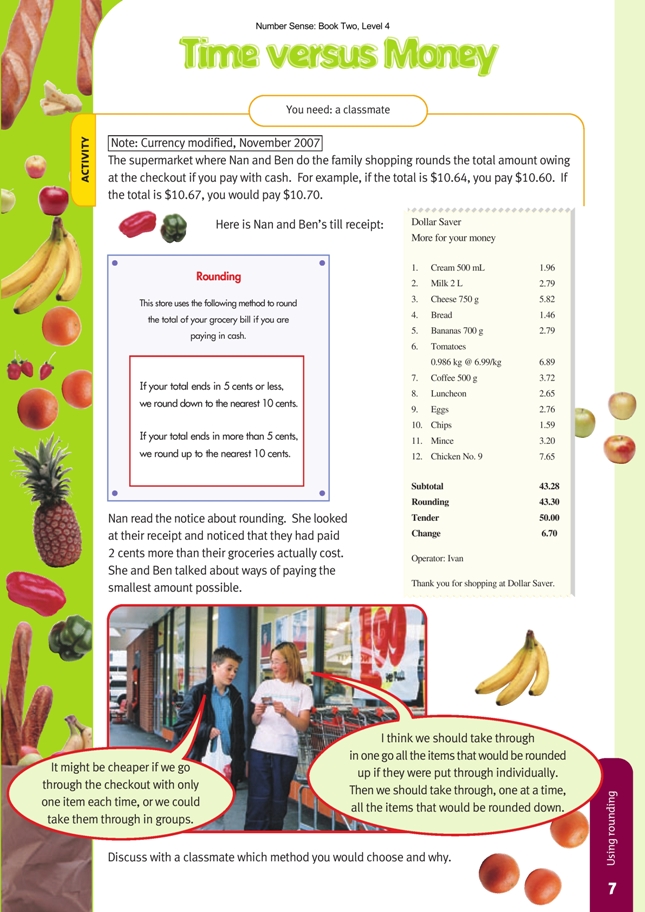This is a level 3 number activity from the Figure It Out series. It relates to Stage 6 of the Number Framework.
A PDF of the student activity is included.
Click on the image to enlarge it. Click again to close. Download PDF (719 KB)
round to the nearest 10c or 5c
A classmate
The activity here is a true investigation in the sense that a number of strategies for paying for the items could be investigated to determine which would yield the cheapest option. The answers for this question provide details about the effect of trying Ben’s two proposals and also about the outcome of trying Cherie’s suggestion
for this particular example. They also point out that, given the reality of shopping in a supermarket, it is unlikely that the time spent trying to save a few cents is actually worth it.
The students may notice that, on the Dollar Saver receipt, one price would not get rounded at all (the No. 9 chicken), eight prices would be rounded up, and just three would be rounded down. It may be useful to identify which items fit into which categories as a basis for investigating Ben’s and Nan’s propositions. These
could then be set out in a chart, for example:
Several extensions of this investigation are possible. The first would be to challenge groups of students to find a grouping of items that minimises the total cost of the groceries. For example, pairing items that would be rounded up individually (rather than putting them all together in one group as in Nan’s suggestion) can result in further savings and bring the bill down to under $43.20. Another would be to have groups of students list the prices of 12 or more randomly chosen different items from a local supermarket or grocery store (perhaps from the pamphlets they put in letter boxes) and carry out a similar exercise to determine the effects of rounding. (Note, too, that online grocery shopping is available in New Zealand, so prices of grocery items
should be available over the Internet if they are not easily obtained locally.)
A further extension activity would be to have the students investigate what a supermarket stands to gain, say, in a year, if every customer ends up paying 2 cents more than the actual price each time they shop.
Answers to Activity
Solutions will vary. Ben’s first idea wouldn’t work in this case because more of their items (8 out of 12) round up so they would end up paying more ($43.30). For Ben’s second method, they would have to work out which items to group together so that overall it would cost them less than the extra 2 cents they paid with one bill. One way would be to pay for the first four items ($11.96, rounded to $11.95), then the next three items ($13.45, no rounding required), and then the last five ($17.82, rounded to $17.80). With this method, they would actually save 3 cents, instead of
paying 2 cents extra.
With Nan’s method, they would also save 3 cents rather than pay 2 cents extra. The combined items (all those that end in 3, 4, 8, or 9 cents) come to $23.23, which
would be rounded up to $23.25. Items rounded down individually would add up to $12.30 altogether. The chicken, which involves no rounding, could be included
in the first group or be paid for individually. The total for all items is $43.20.
However, given that the items are probably all mixed up in the trolley and have bar codes instead of prices on them, the time taken to save 3 cents may not be worth it … So you would probably decide to just pay the extra 2 cents!
Note that, if you pay by EFTPOS or credit card, you would pay the actual total without any rounding.

